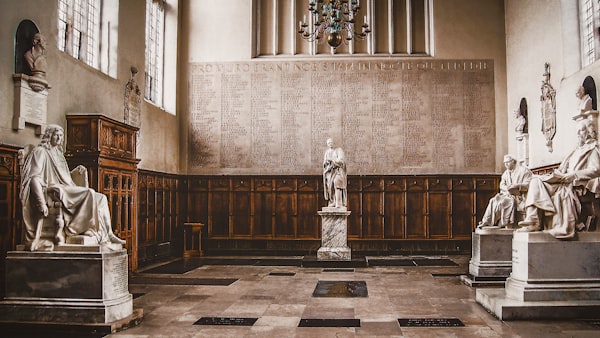Film Discussion 12: Sweet Smell of Success
Above you'll find our discussion on the 1957 film, Sweet Smell of Success, and as always, below are the show notes. We discuss the relation between success and power, whether you can have one without the other, Sidney and JJ's relationship and what ultimately caused their undoing, J.J.'s similarities with Michael Corleone in The Godfather, and more. Oh, and of course, our favorite lines from the film! Let us know what you think in the comments below!
Show Notes
1. "The Sweet Smell of Success" by Roger EbertAlthough Falco is in exile as the story opens, Hunsecker cannot quite banish him from his sight, because he needs him. How does the top dog know he rules unless the bottom dog slinks around? Falco sits down at Hunsecker's table and the columnist senses he's there without even needing to look around. He holds up an unlit cigarette and in the movie's most famous line says, "Match me, Sidney."
2. "Sweet Smell of Success: The Fantastic Falco" by Gary Giddins
Falco dominates the film, including its opening and closing shots, because he gets to make a moral decision, one in sync with the topical conundrum of ruining lives by naming names. He is, he acknowledges, at a crossroads. Hunsecker, not satisfied with having dispatched Susie’s lover, the jazz guitarist Steve Dallas (Martin Milner), wants Sidney to destroy him, and Sidney rears back on his hind legs: “I swear to you, on my mother’s life, I wouldn’t do that. Not if you gave me a column would I . . .” J. J., who knows how cheaply souls are bought, smiles as he seals the bargain.
An interesting comparison on the film and it's characters to The Great Gatsby:
A more significant antecedent to Sweet Smell of Success is curiously embedded here. Keeler had met Costello through their mutual involvement with the El Fay Club, a Broadway speakeasy where Keeler worked as a featured dancer from age fourteen. Fronted by Texas Guinan, Winchell’s mentor and Broadway’s most recognized hostess (who played a version of herself in Broadway thru a Keyhole), the El Fay was owned by bootlegger Larry Fay, who helped inspire F. Scott Fitzgerald’s characterization of Jay Gatsby. It’s impossible now to know how consciously and deliberately Mackendrick and Odets borrowed from The Great Gatsby, yet the connections are plentiful—large and small, inadvertent and unmistakable, and crucial to the film’s structure.
Both the novel and the film are perfect storms of lies and deception, and the latter employs techniques from the former to dramatize the situation without lining up parallel characters. Hunsecker is initially introduced not in the flesh but on an advertising banner that is the film’s controlling symbol: the eyes of J. J. Hunsecker, overlooking the conduct of Broadway’s plodding mortals. This, of course, appropriates The Great Gatsby’s ash heap billboard of the eyes of Doctor T. J. Eckleburg. Hunsecker’s delayed appearance exemplifies what Orson Welles once described as a Mr. Wu device, after the 1913 play of that name: for an hour, everyone talks about the mysterious Mr. Wu, so that his arrival is the play’s dramatic high point. (Welles had a Mr. Wu role in The Third Man.) With the arguable exception of Moby-Dick, the most celebrated example of that device in American fiction is The Great Gatsby: for the first quarter of the book, everyone gossips about him—Who is he? Where is he? How did he make his fortune? Did he kill a man? Is he European nobility?—until Nick sits unknowingly at Gatsby’s table. J. J. is likewise the subject of every conversation until Sidney, biting his nails, works up the nerve to approach his table. Both of their entrances take place in the presence of well-known personalities who underscore their importance.
J. J. is not Jay, though Gatsby’s genuinely romantic pining is as unfulfilled as the columnist’s twisted desires. In many respects, Falco is the truer burlesque of Gatsby, the man who changes his name and history, who blithely commits crimes to advance his ambition, and who has no future. In Hunsecker’s altercation with Dallas, he resembles the violent and hypocritical husband in The Great Gatsby, Tom Buchanan. Each man fights for control of a weak and indecisive woman, and wins her with logical contortions and threats. The two scenes involve quartets. Tom, Gatsby, Daisy, and Nick create almost a template for J. J., Dallas, Susie, and Falco. In each scene, there is a fifth person, a distracted witness: Daisy’s friend Jordan and Sidney’s uncle Frank. As the accusations fly, Fitzgerald’s description of Daisy suits Susie exactly: “But with every word she was drawing further and further into herself . . . ‘Please, Tom! I can’t take this anymore.’ Her frightened eyes told that whatever intentions, whatever courage she had had, were definitely gone.” Tom and J. J. wrap themselves in devious platitudes. J. J. sees himself as a beacon for the American public. Tom Buchanan prattles: “Nowadays people begin by sneering at family life and family institutions, and next they’ll throw everything overboard and have intermarriage between black and white.” Nick describes him: “Flushed with his impassioned gibberish, he saw himself standing alone on the last barrier of civilization.”
Other parallels are apparent: repressed sexuality, odd biblical references, self-delusion, the symbolic use of cars, observations regarding corruption and incorruptible dreams, the ultimate isolation of Jay and J. J., and more.
3. "Another Bite From That Cookie Full of Arsenic" by A.O. Scott
But as Kurt Andersen suggested in a recent article in The Times Magazine, the movie has proved prophetic: the innuendo-mongering, double-dealing and insider information-trading practiced by its press agents and tabloid columnists is no longer confined to a Midtown subculture. Thanks to cable television, the glossies and the Internet, we can all fancy ourselves denizens of what Weiler called the ''bistro belt'' without having to spend a dime on coat room tips.
...the dialogue, courtesy of Ernest Lehman and Clifford Odets, a high-toned street vernacular that no real New Yorker has ever spoken but that every real New Yorker wishes he could.
4. "Mackendrick and Odets" by Paul Cronin
Watch Sidney in the opening sequence as he moves from the newsstand to his half-eaten hot dog, fretting over what he fails to find in J. J.’s column (by which point we have already twice seen Hunsecker’s insincere face staring out at us—once from the side of a newspaper delivery van, and then in a photo at the head of his column), then tossing the paper into a garbage can before heading to his office/apartment, the front door of which displays a scrappy handwritten note. Observe the staging of the scene in the TV studio with the four key characters: all are at play in a single shot, with Sidney moving among the other three, subtly pointing us toward the dramatic tension at every moment. Recall Tony Curtis’s signature gesture in the film: his demonstrative, overwrought nail biting. And look at the way Lancaster and Curtis move together along the claustrophobic nocturnal Manhattan streets. J. J. displays a powerful physical presence (Lancaster, a former circus performer and acrobat, was over six feet tall), stiff and upright, dominating the desperate gadfly Sidney, who flutters around him, almost begging for scraps. Even with the soundtrack turned down, we would know precisely who these men are to each other.




